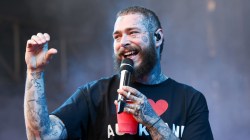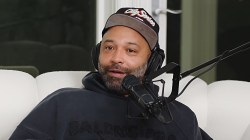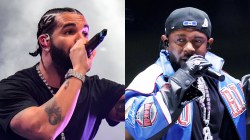Diamond D‘s career is just as bright as his name would suggest. As one of Hip Hop’s most decorated producers, he’s worked with everyone from Brand Nubian, KRS-One and Big L to The Fugees, Busta Rhymes and the late Sean Price. But as successful as he is a producer, Joseph Kirkland is just as lethal behind the mic.
Before the likes of J. Cole, Kanye West and Mac Miller made millions spitting raps to their own beats, Diamond D — who came up under the tutelage of Jazzy Jay of Afrika Bambaataa’s Universal Zulu Nation — pioneered pulling double duty as both rapper and producer, and at times even lent his gruff and elastic bars to other people’s production, such as A Tribe Called Quest‘s “Show Business,” taken from the Queens group’s second studio album, The Low End Theory.
AD LOADING...
But the New Yorker’s crowning moment came with the release of his 1992 debut album, Stunts, Blunts & Hip Hop. Released 30 years ago today (September 22), Diamond D, under the moniker Diamond D And The Psychotic Neurotics, dropped off a 23-track masterpiece packed full of illuminating tales, powerful messages, raw raps and sidesplitting skits, and arrived on the same day as his Diggin’ in the Crates (D.I.T.C.) brethren Showbiz & AG’s debut album, Runaway Slave— which he also produced on.
While Stunts might not have been the huge commercial success some expected it to be, it did go on to become an underground classic that Hip Hop aficionados all over the world wax lyrical about regularly. Praised for its unrelenting production, most of which is handled by Diamond D but includes input from Large Professor, Q-Tip, Jazzy Jay, Showbiz and The 45 King, the album also features some of the earliest appearances from Fat Joe and Big L.
AD LOADING...
Fresh off the release of his sixth solo album, The Rear View, Diamond D talks to HipHopDX about the making of Stunts, Blunts & Hip Hop, the true identity of The Psychotic Neurotics, mentoring Fat Joe early on in his career, sample budgets and a whole lot more.
HipHopDX: We’re here celebrating 30 years since the release of Stunts, Blunts & Hip Hop. Does it feel like it’s been that long?
Dimond D: Time moves so fast, but it definitely doesn’t feel like it’s been 30 years. It feels more like 25. It’s just the way time moves, that’s all.
Can you remember the moment you started working on the album?
I started right after working on Lord Finesse’s second album, The Return of the Funky Man. So I’d put it at the top of ’91.
Besides Lord Finesse, you had also been producing for Busy Bee and as part of the group Ultimate Force with Master Rob. Did you always have it in your mind that you were going to do a solo album where you rapped?
No, I didn’t have any intentions. I was actually doing demos for an artist that Chemistry Records wanted to sign, an artist from my neighbourhood named Joe Control. I was doing his demos and I rhymed on one of them. One day they asked me to come down there. I thought I was going down there to get some money for producing the demos, and they actually offered me a deal. So it kind of fell in my lap.
You mentioned Chemistry, the label Stunts was released on, which was the US subsidiary of British pop music mogul Pete Waterman’s PWL label, home to the likes of Kylie Minogue, Jason Donovan and hit record producers Stock Aitken Waterman. Were you aware of its history when you signed?
AD LOADING...
I didn’t know it was a famous label for pop, disco and dance. I had no knowledge of that prior to signing. PWL had a situation with Mercury Records at the time, which has now been morphed into Universal Records. So I was signed to a boutique label that was distributed by PWL. Artists like Ed O.G. & Da Bulldogs was over there. I never met Pete, though.
Word is Grand Puba was the one who inspired you to start rhyming. Is that true?
Well, I was around Grand Puba a lot because he was signed to Strong City Records, the same label that I was signed to. He was in a group called Masters of Ceremony; I was DJ-ing in the Ultimate Force. Around this time, I was also working on Lord Finesse’s first two albums. They were the two main MCs I was around; so after spending a lot of time with them in the studio it just kind of rubbed off. I was already writing but I didn’t really start to take it seriously until just being around them and watching how they crafted there stuff.
Was there ever any hesitation or doubt in your mind that you could even do a solo rap album?
No, because I didn’t set out to be an MC. Like I said, it just fell in my lap. Once I said I was going to do it, I just never looked back.
Where did the album title come from?
It was a play on sex, drugs and rock and roll.
The album was put out under the moniker Diamond D And The Psychotic Neurotics. Who exactly were The Psychotic Neurotics?
It was me and four other people. It was my DJ KX. It was my hype man Whiz One, and then Sha-Ease and my man Tommy, they were the dancers. So all together there was five of us. Sha-Ease is DJ Sure Shot now, but back then he was one of the dancers. Back in early ‘90s, groups had dancers. So I had two dances, my DJ, and my hype man. These were the people who were around me when I was making the album. Even though none of them are rhyming on there, but we had all bonded, we were always around each other back then.
AD LOADING...
There’s long been a mystique surrounding the identity of The Psychotic Neurotics. You’ve previously mentioned the names Lee and Jigga as being a part of the group. Who are they?
Lee, that’s actually Tommy. They’re the same person. But when I was in the Ultimate Force, Lee and Jigga were the dancers for the group. Once Ultimate Force disbanded, I put [Tommy] in the new group that I had just formed, The Psychotic Neurotics.
Where did the group’s name come from?
I put a couple of names in a hat and picked that one out, literally. I thought it was kind of fly and so I just stuck with it.
Can you remember the other names you were considering?
The Dirt Bags and uh… let me stop.
What are some of the most memorable sessions from the making Stunts?
Aw man. “Best Kept Secret,” “A Day in the Life,” “Step to Me,” “Check One, Two,” “[K.I.S.S.] Keep it Simple Stupid,” “Stunts, Blunts & Hip Hop,” damn near everything. “Sally [Got a One Track Mind].” Everything. The intro.
Are there any particular reasons for you choosing those sessions?
Well, because this was my first time creating something on my own. I was already producing stuff for Brand Nubian and Lord Finesse, and Busy Bee — he was also signed to Strong City Records — but I was able to take more pride in my creation knowing that I controlled everything. I was only a DJ in the group Ultimate Force, but [with Stunts] I was controlling everything. I don’t really have any stark moments that stick out in hindsight at this point, but just the whole experience of putting everything together and hoping that people liked it.
Were there any records that were left on the cutting room floor that didn’t make the album?
Yeah, there’s one or two that I still have. One is called “Diamond in the Rough.” It was produced by Skeff Anselm who worked with A Tribe Called Quest and De La Soul after that. The other one I don’t remember offhand.
AD LOADING...
The album has 23 tracks and a runtime of 66 minutes, which was quite long for a rap album during that time. There were a handful of artists putting out lengthy projects, but not many. What was the thinking behind that?
I actually hated that. I felt it should have only been about 14 tracks at the most. But the A&R at the time, his name was Brian Chin, he said: “No, no, we want to put it all out.” You wouldn’t do that now, that’s a double album. You could put out one album with 11 songs and then follow it up six months later with a 12-track album and it’ll still equal 23. It didn’t make no sense to me.
Whose idea was it to do the ‘Can You Keep A Secret’ write-up inside the album’s liner notes?
That wasn’t my idea, that was somebody at the label’s idea. This was 30 years ago. I don’t know if it was Martha Reynolds, Leslie Ann Dry or a young lady named Paula, or a collaboration of all three of them.
AD LOADING...
You didn’t get to sign it off?
No, they came to me with the idea. First of all, you don’t sign off nothing when you’re a new artist. You’re just glad to be there. They did run it past me. They said: “Hey, we think this would be a good idea,” the ‘Can You Keep A Secret’ campaign. And I said, “Yeah, I like it.” And that was it.
There’s a part in the write-up that mentions you and The Psychotic Neurotics wanting to “re-establish the Bronx as the capital of the Hip Hop Nation.” Which borough or region was taking over at that time that warranted this proclamation?
I don’t know. I ain’t give a fuck about that shit. You probably wasn’t expecting that answer but it’s true. I don’t know if the marketing guy was trying to maybe slant it towards the West Coast or [he was] just taking pride in New York. I don’t know what spin they meant with that. But I never really paid attention to it either.
AD LOADING...
Stunts was the first time the world got to hear Fat Joe on a record. Can you talk a little bit about your relationship with him during those early years?
We both lived in the same projects. We both wanted to make a name in Hip Hop. So he came to me and asked me if would I help him. We made some demos; one of them led to him getting signed. But you know, since we were working so close and we were already close friends from being in a projects together, I put him on the album to try to shine some light on him.
How involved was he with the album?
He came to a lot of sessions. Besides being on “Pass Dat Shit” and the outro, a lot of those background vocals and people cracking jokes and doing ad-libs, a lot of that stuff was Fat Joe.
Fat Joe recently did an interview where he talked about you saving his life by pushing him to rap and paying for that first studio session. Can you speak on that?
What he meant by that was helping him transition to start to get away from doing the street shit and coming over to something legit like being a recording artist. But I didn’t pay for the sessions, Joe paid for his own.
What made you want to work with him and have him be a part of D.I.T.C.?
His passion and his delivery. And a lot of the stuff he was talking about he was living. You know? So there was a realness to it. Plus, like I said, we were friends before the music.
AD LOADING...
Big L , another of your D.I.T.C. brothers, was on one of the album’s skits but wasn’t featured on a track. Why was that?
I don’t know. It wasn’t anything deliberate. Around that time he was working on his first solo album, or maybe a year after that. A year or two.
On that skit, he and Showbiz talk about how they’re glad real Hip Hop is back and the “wick-wack bullshit” is gone. Were they talking about anyone in particular?
It wasn’t anybody specific, it was just the era. That was the anti-pop era. It wasn’t cool. It wasn’t cool to go pop. How crazy we were considering where Hip Hop is today.
You’re renowned for your exceptional work with samples. Do you remember how much of the album’s budget was used on samples?
No. I don’t know. I got everything that I was told I was gonna get out of my budget. I’m sure there was a sample budget. But like a lot of albums at that time, some samples, they found out later on.
You’re also considered one of the pioneers as far as speeding up samples goes, right?
Yeah, I was one of the first to start speeding up samples. That’s how I came up with “Sally Got A One Track Mind.” If you ever hear the original “Sparkling in the Sand” by Tower of Power, you’ll see how slow it sounds.
Is it true you made the beat for ‘Sally Got A One Track Mind’ in 30 minutes?
Yeah, that’s all me, and it’s the biggest single on the album, probably.
How often do you listen to the album? Do you go back to it much?
Yeah, every now and then. I love that album, but I’m just so much better lyrically now and so it’s kind of hard to listen to some of them joints.
AD LOADING...
Looking back, is there anything you wish you had done differently with the album?
The only thing I wish I would have did was maybe do more shows. Remember, I was a producer who thought he’d just made a one-off. I was getting so much work as a producer that going on tour was like, “Why? For what? I’m getting $10,000 a track. I’m producing maybe five, six tracks a month. So you bringing in $50,000 a month, $60,000 a month, and you never really started out to be an MC to begin with.” So I didn’t really do a lot of shows. But if I could go back and change anything, I would have done more shows, and taken MC-ing a little more seriously.
Diamond D’s brand new album The Rear View is out now Dymond Mine Records/EMPIRE — listen to it here.





